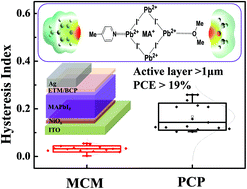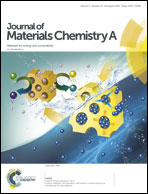Achieving high-performance thick-film perovskite solar cells with electron transporting Bingel fullerenes†
Abstract
Two Bingel fullerenes, PCP and MCM, as electron transporting materials (ETMs) have been developed for achieving thick-film perovskite solar cells (PVSCs) with efficiencies beyond 19% with a planar absorber layer over 1 micrometer. Almost no PVSCs have exhibited PCEs above 18% with a 1 micrometer planar layer before, owing to the excess perovskite defects deteriorating charge extraction and the performance of thick-film based devices. Benefiting from the nearly identical optoelectronic properties of two ETMs stemming from tailored chemical structures, the studies on them allow us to unveil the fact that subtle molecular interaction (anion–π and Lewis acid–base) between ETMs and perovskites strongly affects the charge extraction at the heterointerface, which in turn influences the device hysteresis and performance. Particularly, weak Lewis base–acid O–Pb2+ interaction between MCM and the perovskite helps passivate the trap-states at the interface, resulting in a smooth electron extraction and reduced device hysteresis (the average hysteresis index (HI) of 0.03 ± 0.01). However, the strong N–Pb2+ coordination induces misalignment of the energy levels at the perovskite/PCP heterojunction, causing electron accumulation at the junction, and hence the large HI (0.17 ± 0.05) in devices. This work provides new insights into the charge extraction at the perovskite/organic interface and the possible molecular interaction from organics to cure perovskite defects.

- This article is part of the themed collection: 2018 Journal of Materials Chemistry A HOT Papers


 Please wait while we load your content...
Please wait while we load your content...